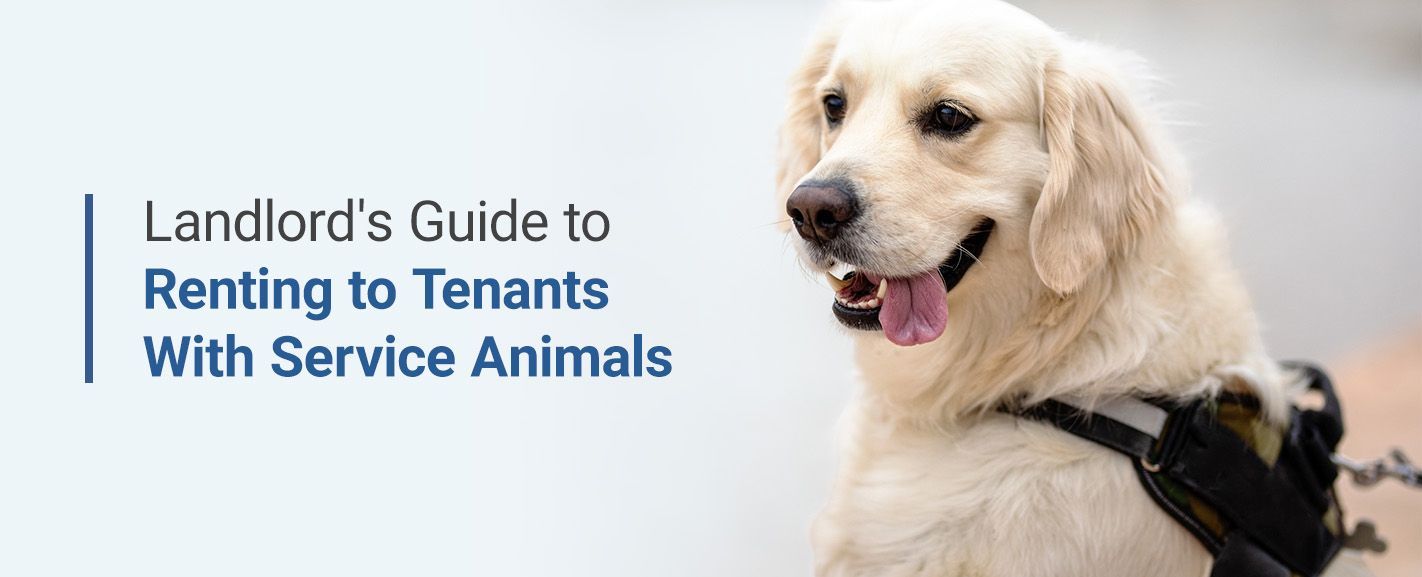Landlord's Guide to Renting to Tenants With Service Animals

Navigating the complexities of renting to tenants with service animals is essential for landlords. This guide provides a comprehensive overview of the distinction between service animals and emotional support animals, legal obligations under the Fair Housing Act and practical steps for modifying lease agreements. It also covers the benefits of accommodating service animals, effective tenant screening processes and tenant education.
By partnering with American Heritage Property Management, landlords can ensure compliance, promote positive tenant relationships and foster an inclusive community. Whether a tenant needs a service dog in an apartment, townhouse or individual home, this article equips landlords with the knowledge and tools to rent to tenants with service animals.
Understanding Service Animals and Emotional Support Animals
Understanding the distinctions between service animals and emotional support animals is crucial for landlords. Learn their roles, legal definitions and landlords' rights and responsibilities under the Fair Housing Act and other relevant regulations.
Service Animal Identification
The purpose of a trained service dog is to assist individuals with disabilities by performing certain and often specific tasks. This could include guiding the visually impaired or alerting those with hearing impairments. According to the Americans with Disabilities Act (ADA), only service dogs qualify as service animals.
Understanding Emotional Support Animals
Emotional support animals (ESAs) are used to support and comfort individuals with emotional or mental conditions. They are not required to have specific or specialized training. The Fair Housing Act (FHA) mandates landlords make reasonable accommodations for ESAs, provided the tenant has a documented need from a licensed health care professional. Unlike service animals, ESAs can be of various species.
Legal Obligations and Fair Housing Laws
Understanding the legal landscape when renting to tenants with service animals is essential. Discover landlords' obligations under the Fair Housing Act and other relevant laws, ensuring compliance while respecting tenant rights and fostering a fair rental process.
Tenant Rights
Tenants with service animals are protected under the FHA, which prohibits discrimination based on disability. Landlords must make reasonable accommodations for tenants with service animals, allowing them to have their animals live with them and assist them within the residence.
Landlords cannot impose breed or size restrictions on service animals, as these animals are essential for the tenant's daily functioning and well-being. This protection promotes an inclusive and supportive housing environment for all tenants.
Rights and Laws Regarding Assistance Animals
Federal laws, including the FHA and the ADA, mandate that landlords accommodate tenants with service animals. State laws, such as the Disabilities Rights Pennsylvania, provide additional protections. By law, landlords cannot deny service animals and service dogs. Tenants would still need to undergo a screening process to determine eligibility, but it is considered discrimination to deny someone purely based on them having a service animal.
Under the FHA, landlords must allow service animals even if their property has a no-pet policy, and they cannot charge pet fees or request additional deposits. Landlords must also make reasonable accommodations for tenants with disabilities, ensuring equal access to housing.
The Department of Housing and Urban Development offers additional clarification regarding service animals.
Lease Agreement Modifications
When renting to tenants with service animals, it is essential to create tailored lease agreements to reflect legal requirements and ensure clarity. Examine how to craft effective service animal policies, ensuring compliance with laws while maintaining a fair and transparent relationship with tenants. Knowing how to write a lease agreement is essential to the rental process.
Crafting Service Animal Policies
To accommodate service animals, landlords should modify existing lease agreements to reflect compliance with federal and state laws. Essential elements to include are:
- A clear definition of service animals and emotional support animals.
- A statement affirming no additional fees or deposits are required for service animals.
- Guidelines for maintaining the property and ensuring the animal does not cause damage or disturbances.
What a landlord can require for a service animal:
- Documentation from a licensed health care professional verifying the tenant's service animal needs
- Confirmation that the animal is trained to perform specific tasks related to the tenant's disability
- Assurance that the animal is well-trained and behaved and will not threaten other tenants or property
Ensuring Tenants Understand Lease Agreements

When renting with a service animal, tenants should be aware of key clauses in the lease agreement. Common modifications include adding specific language about accommodations and tenant obligations to maintain an orderly living environment. Some of the aspects in the lease agreement that tenants with service animals should be aware of include:
- Service animal definition: Clarifying what constitutes a service animal under the law
- No pet fees: Stating that no additional fees or deposits are required for service animals
- Property maintenance: Outlining tenant responsibilities for maintaining the property and ensuring the animal does not cause damage
- Behavioral expectations: Ensuring the animal is well-behaved and will not disturb or affect other tenants
Screening Process for Tenants With Service Animals
A thorough and compliant screening process is vital when renting to tenants with service animals. Discover the steps to ensure landlords meet legal requirements while selecting responsible tenants.
Steps to Ensure Compliance
Conducting a fair screening process for tenants with service animals involves several key steps:
- Review documentation: Verify the tenant's need for a service animal through appropriate documentation from a licensed health care professional.
- Assess property suitability: Ensure the property can accommodate the service animal without causing undue hardship or significant alterations.
- Evaluate tenant history: Conduct standard background and credit checks to assess the tenant's reliability and financial stability.
- Clarify policies: Communicate your service animal policies, including maintenance responsibilities and property care expectations.
Service Animal Benefits for Landlords
Renting to tenants with service animals can offer numerous advantages. These include increased tenant satisfaction and retention, creating a positive community atmosphere and potentially attracting a broader tenant base, all while ensuring compliance with legal obligations.
Advantages of Renting to Tenants With Service Animals
Service animals can enhance the community atmosphere by promoting inclusivity and support for individuals with disabilities. For landlords, accommodating service animals can increase tenant satisfaction and retention, as tenants feel valued and supported.
Additionally, properties that welcome service animals may attract various tenants, including those who prioritize accessibility and inclusivity. This positive reputation can enhance the property's appeal and overall community well-being, creating an agreeable living environment for all residents.
Tenant Education and Support
Educating tenants about service animal policies is crucial. Examine strategies for informing tenants about their rights and responsibilities, ensuring they understand lease agreements, and providing ongoing support to maintain a positive relationship between landlords and tenants with service animals.
Educating Tenants on Service Animal Policies
It's essential to provide tenants renting with a service animal with comprehensive resources and guidance. Offer clear written policies outlining their rights and responsibilities and provide access to relevant legal information. Regularly update tenants on policy changes and ensure they understand the lease terms.
Clear communication promotes trust and transparency, helping tenants feel supported and informed. If you have other tenants in apartment buildings or townhouses, consider hosting informational sessions or providing online or offline resources to address common questions. This proactive approach ensures a positive rental experience and promotes an inclusive living space.
Partnering With American Heritage Property Management
American Heritage Property Management (AHPM) offers expert guidance and comprehensive services to landlords, ensuring compliance with laws regarding service animals. Our team assists in crafting lease agreements, tenant screening and policy development, making the rental process seamless and stress-free. At AHPM, our professional approach helps landlords navigate legal obligations, maintain property standards and foster positive tenant relationships.
By partnering with AHPM, landlords can confidently know that their properties are properly managed and maintained. You will have the support and expertise to accommodate tenants with service animals effectively.
Get assistance renting to tenants with service animals and simplify the rental process and management today. Easily contact us online for further information about how our team can assist.





